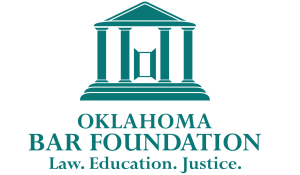Oklahoma Bar Journal
Bar Foundation News | Bridging the Justice Gap: What We Learned From the 2024 Legal Needs Survey
By Renee DeMoss
 When it comes to increasing access to justice in Oklahoma, there’s no substitute for listening. Listening to the stories, obstacles and opportunities that exist in our state. The Oklahoma Bar Foundation recently completed its 2024 Promoting Access to Justice Survey. The survey was wide-reaching and designed to identify and understand the most pressing legal needs across the state. Drawing on data from all 77 counties and insights from more than 1,000 Oklahoma attorneys, the survey report sheds new light on where gaps in legal services persist and what solutions hold the most promise.
When it comes to increasing access to justice in Oklahoma, there’s no substitute for listening. Listening to the stories, obstacles and opportunities that exist in our state. The Oklahoma Bar Foundation recently completed its 2024 Promoting Access to Justice Survey. The survey was wide-reaching and designed to identify and understand the most pressing legal needs across the state. Drawing on data from all 77 counties and insights from more than 1,000 Oklahoma attorneys, the survey report sheds new light on where gaps in legal services persist and what solutions hold the most promise.
This survey is another important step in ensuring the OBF’s grantmaking and programming goals align with the real-world needs experienced by Oklahomans, as observed by the attorneys who serve them. Legal professionals across the state responded to our survey, which divided the state into eight different regions. The survey showed populations in the northwest, southeast and southwest regions are underserved in terms of IOLTA dollars. Access to justice has already been identified as a critical priority in these communities, and our findings provide a clear direction for bringing essential legal resources to close the justice gap for all Oklahomans.
HIGH DEMAND, SHARED NEEDS
The survey report confirms what we already know: Legal needs in Oklahoma are widespread and urgent. Across the board, attorneys identified four primary areas of consistent concern:
- Legal assistance for the elderly
- Affordable housing and eviction prevention
- Family law matters
- Immigration and citizenship issues
What’s striking is how consistently these top needs were cited in all three underserved regions. While some slight regional variations appear, such as consumer protection and debt relief replacing immigration as the fourth most pressing need in the southwest, the broader picture suggests shared statewide challenges.
COMMON BARRIERS, REGIONAL REALITIES
Responses from Oklahoma attorneys also helped shine a light on the barriers their clients face when trying to access legal services. Unsurprisingly, cost remains the single greatest hurdle, especially in the southeast.
In the southwest, lawyers noted that many of their clients are simply unaware of the existing legal resources or unsure of where to turn for help. Attorneys in the northwest emphasized geographic challenges, including the limited availability of legal aid providers and the long travel distances required to receive services.
These insights reinforce the fact that there’s no one-size-fits-all solution. Improving access to justice means addressing both common statewide problems and region-specific limitations.
UNDERSERVED OKLAHOMANS
The survey report also underscores how legal access gaps are especially wide for certain populations.
- Low-income clients remain at a significant disadvantage due to affordability and the limited availability of pro bono resources.
- Clients with disabilities face physical and communication barriers, with the southeast reporting particular concerns.
- Clients with limited English skills struggle to find attorneys or materials in their primary language. This challenge seems especially prominent in the southwest.
TECHNOLOGY: BRIDGE OR BARRIER?
Though technology offers new opportunities to reach remote or underserved communities, many people do not have ready access to computers and the internet in these regions, and they have low literacy rates in the use of technology. Oklahoma attorneys, however, report great interest in online tools, like virtual consultations and self-help legal guides. This suggests that the right infrastructure and technology can help bridge the justice gap.
WHAT COMES NEXT?
The insights from our survey report provide actionable next steps. The OBF has outlined several key recommendations to turn this research into results:
- Community-Based Collaboration: By building stronger partnerships with regional lawyers, bar associations and community organizations, the OBF aims to increase impact at the local level.
- Strategic Grantmaking: The OBF will look to prioritize community-based organizations tackling elder law, housing, family law and immigration issues. Attention will be given to regional disparities, such as consumer debt relief in the southwest and rural access in the northwest.
- Innovation and Capacity-Building Grants: The OBF will explore new grants to support creative solutions, such as mobile legal clinics, virtual legal platforms and AI-assisted tools.
- Technology Infrastructure: Internally, we will invest in upgraded systems to improve communication, grant processing and fundraising, ensuring that our organization can keep pace with the needs we seek to meet.
STAY TUNED
Our survey report is just the beginning. In the coming months, the OBF will share deeper dives into regional data, promising practices from grantees and examples of impact in action. We invite you to stay engaged, lend your voice and help expand access to justice for all Oklahomans.
You can access the survey report at www.okbarfoundation.org/legal-needs-report.
Ms. DeMoss is the executive director of the Oklahoma Bar Foundation.
Originally published in the Oklahoma Bar Journal – OBJ 96 No. 6 (August 2025)
Statements or opinions expressed in the Oklahoma Bar Journal are those of the authors and do not necessarily reflect those of the Oklahoma Bar Association, its officers, Board of Governors, Board of Editors or staff.
